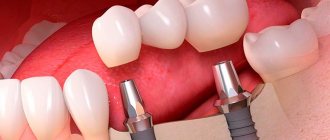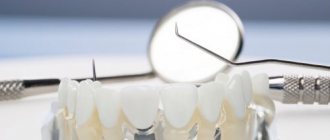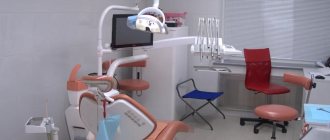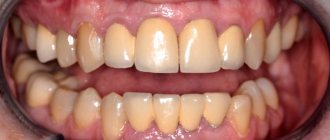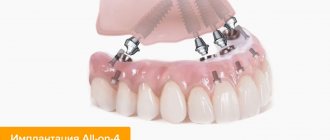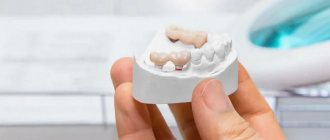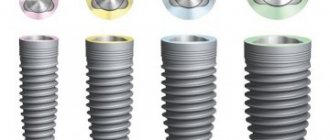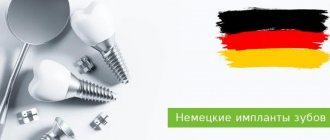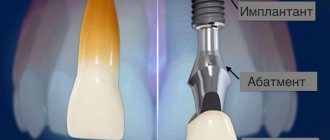A surgical guide is often used to install implants. It is not needed in all cases of implantation, but sometimes it is simply necessary. What it is, how it is made and what it is needed for, we will tell you in this article.
Dental implantation and dental prosthetics on implants are becoming increasingly the preferred method of restoring lost teeth every year. The installation of implants is growing annually in both quantitative and qualitative terms. This method of prosthetics is extremely practical, functional and has very high aesthetic values.
One of the most important factors in the success of a dental implant procedure is the accuracy of implant placement. Today, various computer programs make it possible, using 3D modeling technology, to achieve the most accurate immersion of the titanium root into the bone, with the correct determination of the depth and angle of inclination.
Surgical template - what is it?
It is a mouthguard, which is essentially a stencil-overlay. Depending on the clinical picture, it is fixed in the oral cavity on the bone, on the mucous membrane or on preserved teeth. The template contains guide holes through which the specialist actually directs the implant to a precisely specified location, to the required depth and angle of location.
Using a surgical template, the implantologist installs implants with high precision, eliminating errors that may be caused by human factors.
Types of templates and materials for their manufacture
The requirements for implant templates are high. This is due to the fact that the safety of human health is placed above all else during any dental procedures. The manufacturing material must be hypoallergenic and not change its qualities and properties after sterilization. Acrylic and medical polymers are used as a base. Currently, two types of templates are most often used for implantation: those based on teeth and those based on the oral mucosa. The first option is used when there is a sufficient number of dental elements. The second is used if the patient has very few teeth or is completely edentulous.
Situations for using a surgical template.
- Implantation and prosthetics using the All-on-4 (all-on-6) method.
- There are cases when the installation of implants is possible when there is insufficient bone tissue without its preliminary restoration. The template makes it possible to place the implant in a place where there is enough bone to surround the implant.
- If the jaw is missing 3 or more teeth in a row.
- If teeth are completely missing and a large number of implants are required.
- Installation of implants in the frontal (front) segment of the jaw, where there are very high requirements for the aesthetic component.
- In the case of conditionally removable or fixed prosthetics using beam fastenings.
Making a surgical template is always an individual process for each patient. It is done in specialized dental laboratories, which are equipped with the necessary modern equipment.
How templates for implantation are made
To obtain a template with maximum positioning accuracy, 3D modeling technology is used. And production is entrusted to specialized dental laboratories. First of all, the patient is examined on a computed tomograph, then impressions of both jaws are taken. Then the casts are scanned (digitized) and combined with the data obtained during tomography. Based on the information received, a 3D model of the template is created, on which the exact location of future implants is determined using computer modeling. The final stage of creating an implantation stencil is the implementation of the virtual model into a real object using CADCAM computer technology.
What are the positive aspects of using a template for a patient:
- The invasiveness of the operation is significantly reduced; the implantologist does not need to make incisions; he pierces the gum in the place marked in the template. After such an intervention, healing occurs much faster and more painlessly. The likelihood of postoperative swelling is reduced.
- The operation time is reduced, since the doctor does not need to mark places for installing implants. All this has already been done on the template with high accuracy.
- The prognosis for implantation success is much higher due to the fact that the position of the implants is determined with the most accurate calculation down to the millimeter. The risks of installing implants in the wrong position due to human factors are eliminated.
- It is possible to install a temporary orthopedic structure on the day of surgery.
General overview
Experts note that the use of surgical templates is a serious step in the development of implantation. The device, which is similar in appearance to a sports mouthguard, follows the shape of the jaw row, but at the same time a number of holes with the same diameter are placed in its surface, allowing the dentist to determine the area of integration of the artificial base. Tight fixation eliminates displacement during the formation of channels for implant placement, increasing the accuracy of prosthetics.
Templates, made taking into account the anatomical features of the structure of the jaw apparatus, ensure precise fitting of artificial crowns after installation. Thus, as a result of the restoration, a complete dentition is created that corresponds to the patient’s occlusion and bite, and does not require getting used to the implants.
There are only two disadvantages of using a template for a patient:
- It takes extra time to make it.
- Additional financial payment for template production. But making a template does not always lead to an increase in the cost of implantation. In the case when it is used when there is a lack of bone tissue, given the absence of payment for bone grafting of teeth, implantation becomes cheaper using a template.
Considering the listed advantages and awareness of the complexity of the procedure, focusing on a high-quality long-term result, it is unlikely that these disadvantages can play a decisive role in order to save time and money.
Procedure for making a surgical guide.
The production of the template, as well as the implantation procedure, in the Es-Dent center, starting from the initial consultation, is planned by two specialists in the complex: an orthopedic dentist and a dental implant surgeon.
First stage.
Diagnostics. The patient is given a 3D image on a CT scanner. After careful analysis and planning of implantation: choosing the type of implants, determining their location, choosing an orthopedic design, the orthopedic dentist takes impressions (casts) from the patient’s jaws.
Second phase.
3D modeling. The casts are scanned, taking into account the diagnostic data, and a 3D model is created. A specialized computer program models and calculates the exact location of the planned implants, and a model of the orthopedic structure is also created.
Third stage.
Manufacturing. Based on the created model, the production of a surgical template begins, which will contain guide holes for implants and special fasteners for fixation on the patient’s jaw. The template is made in laboratory methods or on modern equipment using CAD\CAM computer technology.
For more information and to make an appointment with a specialist, call:
+7,
Advantages and disadvantages of application
Advantages of using templates during implantation:
- high accuracy of installation, as a result – maximum degree of osseointegration;
- eliminating the influence of the human factor;
- efficiency of surgical intervention;
- reducing the trauma of the operation (no incision on the mucous membrane is needed);
- rapid healing of the surgical wound;
- minimizing the risk of postoperative complications.
Flaws:
- the need for additional time to make the template (1-2 days);
- increase in the final cost of implantation (except for the case when the use of a template allows one to avoid osteoplasty).
The network of dental clinics “Smile” offers patients dental prosthetics services supported by implants. We perform implantation using various technologies, including using surgical templates for implantation. Contacting our branches has significant advantages:
- implantation is performed by highly qualified surgeons;
- all dental procedures are carried out in accordance with international standards;
- family and cumulative discounts are provided;
- pricing of services depends on the characteristics of the clinical case, the use of a certain technology and the cost of the implantation system;
- We work according to a schedule convenient for patients: every day until 21:00 (on Sunday until 16:00).
You can make an appointment at any of the branches of our clinic in Moscow, located within walking distance from metro stations:
- Alekseevskaya (VDNKh district, etc. Mira), address: st. 3rd Mytishchiskaya house 3, building 2;
- Shelepikha, address: Shelepikhinskaya embankment, address: building 34, building 1.
The use of innovative technologies, extensive practice and modern equipment of the clinic allow us to successfully perform dental implantation using any method, regardless of the complexity of the clinical situation. We guarantee the safety and effectiveness of our services. We will restore the attractiveness of your smile!
Myths about using a surgical navigation template
1. When using such a surgical instrument, the price of implantation services increases significantly, which is why it is prescribed to patients. It is better to find a competent and honest specialist.
It should be noted that no matter how qualified and conscientious a surgeon is, a person cannot surpass high-precision computer calculation technologies and digital technology. In this case, the human factor plays an important role, since the doctor may be tired, stressed or ill.
That is, if a specialist talks about using a surgical template, this indicates his responsible approach to his work and his patients.
2. The use of a template indicates a low level of professionalism of the dentist.
This is also a mistaken opinion. As practice shows, only incompetent specialists demonstrate complete confidence in their professional skills. A competent doctor understands that errors and miscalculations are possible when performing any dental procedures, and makes every effort to prevent them.
This is precisely what formed the basis for the creation of a surgical template: with its help, it is possible to eliminate many serious shortcomings when performing dental implantation.
3. Why make any markings on the jaw? A dental implant can take root in any area.
In addition to fixing the implant, the installation of an orthopedic structure is of great importance, which must have the following characteristics:
- Strength, which ensures resistance to any chewing loads;
- Safety for the human body, which eliminates the possibility of bone tissue destruction;
- Convenience, which increases patient comfort during use;
- Aesthetic perfection.
This indicates the importance of choosing the right location and determining the exact inclination of fixation of dental structures, which play the role of supports for future crowns.
Author:
Why is it necessary?
The surgical template is a structure shaped like a boxing mouthguard, with identical holes present on the surface. The main purpose of the products is to accurately determine the implantation zone. With the help of the design, the implant is implanted steadily and along the contour.
They are made individually for each patient, based on the characteristics of the jaw and the location of the patient’s teeth.
Their main purpose is to ensure the exact location of the artificial tooth in the dentition.
The materials used for manufacturing are lightweight - acrylic, plastic, polymer, so the product is easy to use.
In what cases is IMPLANTATION without incisions used?
At Belgravia Dental Studio clinics, we widely use atraumatic implantation technology using a surgical template. Most often, implantation without incisions is performed:
- when a patient needs multiple implantations for edentia (complete absence of teeth on one or two jaws),
- during implantation with immediate loading (when a temporary crown is placed on the implant on the day of installation - as a rule, this happens in the smile area, that is, on the front teeth).
How to install implants using a template
- Photo protocol
Take a series of photos of a person’s face: from the front, in profile, with his mouth open and closed, smiling. The photo protocol helps to determine what changes in the bite and facial symmetry occurred during the absence of elements. The materials are used to evaluate the outcome of treatment. - Computed tomography
During the procedure, images of the jaw bone are obtained in volume. In the image, the doctor recognizes the quality and volume of bone tissue, the position of the elements, their roots, jaw nerves, and maxillary sinuses. The transmitted information is entered into the program. - 3D visualization
A computer program simulates the patient's jaw system. A virtual operation is performed to remove the units, and locations for artificial roots are determined—the areas of the densest bone of the appropriate volume. Based on the model, implants are selected and the design of the prosthesis is worked out. - Installation of implants
The rods are installed using a minimally invasive method - without incisions, through a gingival puncture. The implants are screwed into the bone tissue at the site of the hole on the template. - Taking impressions
The procedure is necessary for the final modeling of the prosthesis base and elaboration of the product taking into account the bite. This is an important stage when restoring part of the dentition or one jaw. A HIP analyzer is used to assess the level of jaw closure. The resulting casts are the basis for a model of the jaw system, which is fixed in an articulator device, which helps to take into account the functionality of the temporomandibular joint. - Prosthetics
After implantation, the dental technician adjusts and adapts the metal base of the prosthesis to the patient’s bite, veneers it with acrylic, and installs metal-plastic crowns. The result is a temporary prosthesis with artificial gum. The patient will have to wear the adaptive prosthesis from 3-6 months to 5 years (depending on the implantation method).
Indications for use
- Absence of three or more teeth in one jaw row.
- The need to replace the front teeth with implants.
- Identified clinical anomalies in the structure of the jaw, which imply the need to drill at a large angle.
- The need for a flapless, minimally invasive surgical solution.
- Installation of a fixed or conditionally removable beam structure.
- Immediately after the implant is placed, a temporary crown will be placed on it.
- The patient has bone atrophy, and the implants need to be directed into the processes of the jaw that go to other bones.
Indications and contraindications
The reasons for the use of a surgical template include the following situations:
- Extended adentia, characterized by the absence of a large number of teeth and the presence of large empty areas, making it difficult to determine points for installing artificial pins;
- Absence of frontal elements of the dentition, the replacement of which is associated with increased aesthetic requirements;
- The need to organize canals at a wide inclined angle, caused by clinical anomalies in the structure of the jaw apparatus;
- Manufacturing of temporary prosthetic structures;
- The need for flapless surgery.
At the moment, no restrictions have been identified that would prohibit the use of a template, not counting factors that cast doubt on the feasibility of implantation as such. The latter include chronic pathologies, oncology, heart failure and other diseases.
Prosthetics
Immediately after surgery, a healing abutment, temporary crown, or bridge can be placed on the implants. They need to be worn for 2 - 4 months while the process of osseointegration takes place - the artificial tooth roots must be securely and firmly fixed in the jaw and overgrown with bone tissue. The temporary structure does not reveal itself in any way and does not differ in appearance from natural teeth. After completion of osseointegration, the patient is invited to install a permanent crown or prosthesis made of ceramics, metal-ceramics, zirconium dioxide - the material is selected at the request of the patient.
Navigated implantation VS Manual implantation
If we summarize all the above-mentioned advantages of implantation using a template, then in terms of all characteristics, preference should still be given to modern digital technology over the old, but cheaper method.
| Navigated implantation with surgical template | Manual implantation | |
| Degree of injury | Low | High |
| Positioning accuracy | High | Low |
| Time | From 20 minutes to 1 hour | From 1 hour to 6 hours |
| Possibility of rejection | Low | Average |
| Recovery period | 1-2 days | 3-10 days |
| Price | 150-1000 € | Included in the cost of the procedure |
How is 3D implantation performed?
The surgeon fixes the template in the patient’s mouth and places the implants exactly according to it. Flap surgery is not required: the doctor makes only small punctures in the gum, the diameter of which corresponds to the size of the implants. Thus, the traumatism of the operation is minimized, the gums do not need to be sutured, and there is no risk of developing inflammation with good oral hygiene. Implantation is performed under local anesthesia. It takes 10 minutes to install one implant. The possible error does not exceed 20 microns.
